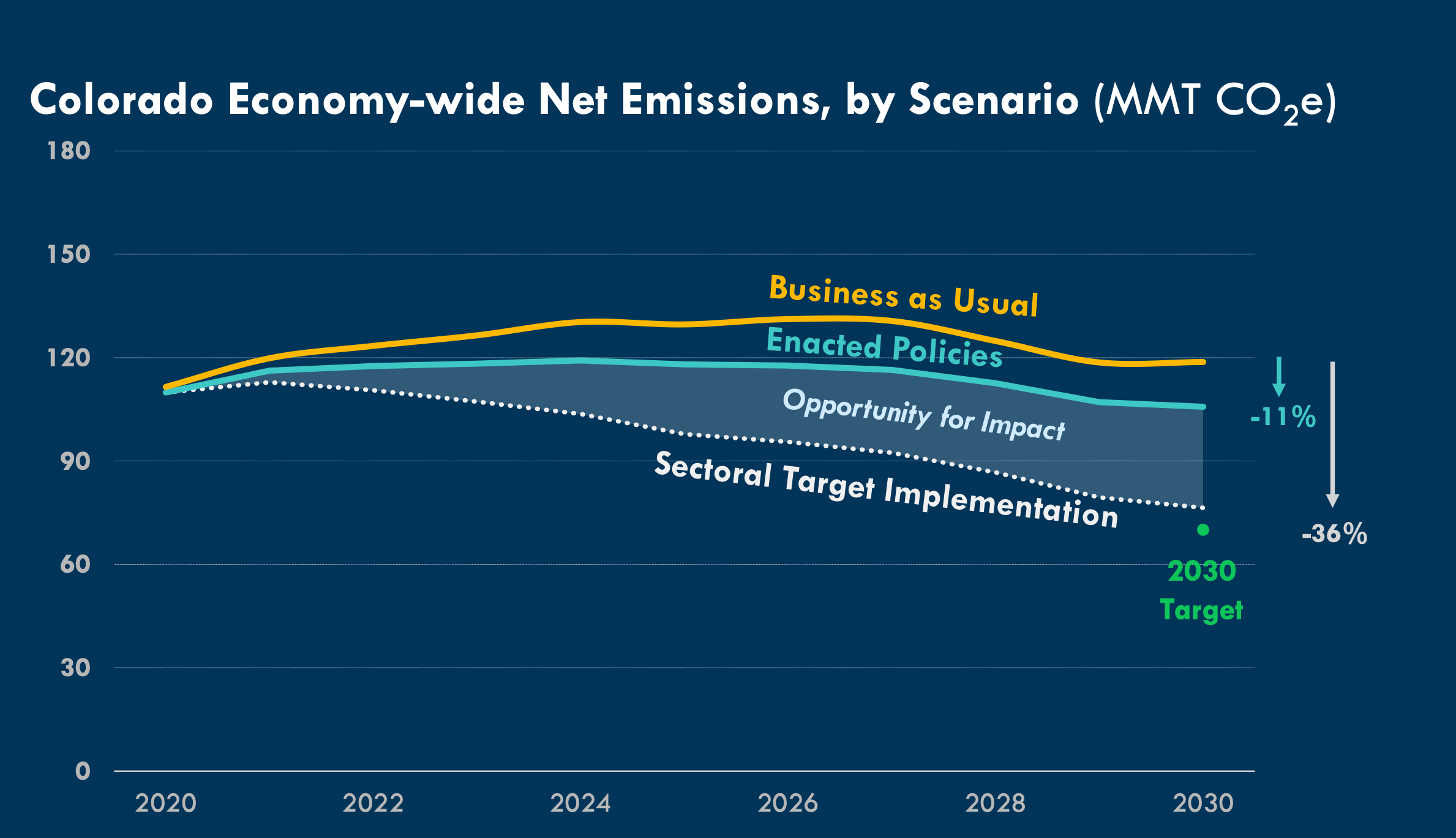Beautiful Denver Skyline at sunset

Colorado’s Role as Climate Leader Hinges on Its Next Steps
Colorado has the potential to take monumental strides in greenhouse gas emissions reductions in 2021, new RMI analysis shows. But just how successful the state is in driving down emissions depends significantly on how it implements newly passed legislation.
Today, RMI and our partners at Energy Innovation have published two new policy scenarios in the Colorado Energy Policy Simulator (EPS)—a real-time, open-access modeling tool—to assess the emissions impact of 2021 state legislation. Our modeling shows that while signed legislation has set the stage for significant progress, roughly three-quarters of the emissions reductions targeted in 2021 bills depend heavily on state agencies writing rules and regulations to achieve the reductions, in procedures known as rulemakings. If current rulemakings implement actions ambitious enough to meet policy targets, Colorado may be within reach of its 2030 goal of reducing emissions by 50 percent below 2005 levels. However, as of today the state risks falling short of this goal.
During the 2021 session, the Colorado legislature and the administration of Governor Jared Polis passed policies to accelerate decarbonization in nearly every sector of the economy while improving public health and stimulating the state’s economy. The legislation included policies to ramp up renewable energy deployment, electrify the transportation sector, drive down emissions from buildings, and stop methane pollution at the source. Now it is critical that regulators take steps that enable these policies to achieve their intended goals.
Two Possible Futures
The two new scenarios evaluating the impact of 2021 legislation are available in the Colorado EPS today—and details about our modeling assumptions are available here. The Enacted Policy Scenario estimates the impacts of 2021 legislation that took effect immediately and do not rely on follow-on rulemaking. The Sectoral Target Implementation Scenario estimates the additional emissions reductions that could come from rulemakings for 2021 legislation—showcasing the path that is possible if policy implementation achieves legislated targets.*
When compared to the Business as Usual (BAU) Scenario, which reflects Colorado’s decarbonization progress as of early 2021, the updated modeling illustrates two important insights:
First, Colorado needs new policies that drive significant progress. Looking first at the Enacted Policy Scenario, we found that components of recent legislation that are already in effect will drive down total emissions by roughly 10 percent in 2030 as compared to the BAU. This progress is concentrated in the power and buildings sectors, where new policies (HB21-1266 and SB21-264) codify and expand targets for emissions reductions and take an innovative approach to cost-effectively cutting natural gas emissions, respectively.
Second, enacted legislation is often not sufficient—new rulemaking resulting from legislation is also key. The Sectoral Target Implementation Scenario captures the potential impact if implementation is successful in meeting targets identified in the new policies. We find that these rules—which implement new or updated targets in the industrial, oil and gas, and transportation sectors—could close most of the gap between the state’s BAU path and its 2030 target. In this scenario, full implementation of legislated targets from the 2021 session would drive down emissions nearly 40 percent compared to the BAU in 2030. Enacted policy alone can achieve only about a quarter of that reduction. However, these reductions are far from guaranteed—they will require significant investment, strong rules, robust enforcement, and transparent evaluation.
The oil and gas sector is a prime example of the importance of policy implementation for driving emissions reductions. In the Sectoral Target Implementation Scenario, methane abatement accounts for nearly half of the total emissions reductions across the state’s entire economy as compared to the BAU in 2030. Meeting this level of ambition requires implementation of rules that are strong enough to meet legislated targets. Regulators will consider rules focused on translating this ambition to action in December. Effective implementation in this sector is not only necessary for Colorado to get on track toward its 2030 climate goals—it is also critical because methane supercharges warming in the short term, intensifying climate risks and resulting in greater damage.
Taking the Next Step
Having laws on the books that could put the state’s 2030 goals within reach is an important achievement to celebrate, but it is not the finish line. The next step—implementing and enforcing robust regulations that deliver on the goals of that legislation—is just as important. In transportation, Colorado must ensure that rules uphold strong targets that drive significant investments in multimodal transportation options. For oil and gas, the state must invest in measurement that enables effective enforcement of methane abatement. And for industry, Colorado must ensure that the ongoing rulemaking series includes strong accountability mechanisms.
Furthermore, while success on all fronts may bring Colorado very close to being on track, additional policy will be needed across most sectors to hit 2030 targets and lock in additional emissions reductions in the future. Colorado has built a strong foundation for climate leadership, as reflected in its current portfolio of ambitious policy. Now it must build on this leadership by pairing strong policies with strong implementation to meet emissions goals and help ensure a safe climate future.
* The analysis does not include assumptions about potential federal climate policy and infrastructure investments, which could dramatically change expectations across all scenarios. Furthermore, some rulemakings are already underway, but we do not attempt to reflect progress to date. See our methodology for more information. RMI plans to release updated modeling in 2022 to estimate the impacts of completed rulemakings.

